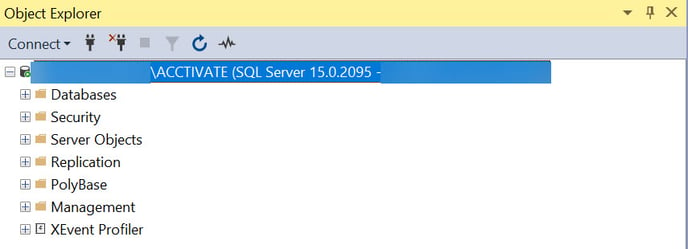Connecting the Acctivate database to Microsoft SQL Management Studio
For customers who want to access their database, you're able to do so through Microsoft SQL Management Studio (SSMS.) Check out this article for instructions on doing so.
Customers are able to connect their SQL server to Microsoft SQL Management Studio (also known as SSMS) in order to do various tasks such as running scripts, pulling data, viewing logs, creating database accounts and much more. You can view the documentation from Microsoft's docs page here.
For backing up and restoring your database, you're able to perform that in the built in Acctivate Database Maintenance program. You're not required to get SQL Management Studio. See our guide about that here.
Connecting to SSMS is simple and quick. See below for steps to doing so:
- First install Microsoft SQL Management Studio from Microsoft's docs page.
- Open Microsoft SQL Management Studio by searching for it in the Windows Taskbar.
- Upon opening SSMS, you should be greeted with a "Connect to server" window. If not, you can open this window by clicking the "File" menu in the top left hand corner and clicking "Connect Object Explorer"
- Enter your server name and instance in the window, or select from the drop down. This should be something very similar to: SERVERNAME\Acctivate
- If you need this information, open the "Acctivate Database Maintanence" program and navigate to Database -> Database Sources
- Select authentication method. SQL Server Authentication is the recommended, however you can use Windows authentication if your user account is set up as a SQL server admin.
- Enter your login and password credentials. The Login is 'SA' if you need the password, please contact Acctivate support.
- (Optional) Check the "Remember password" box if you'd like to have SSMS remember your ID and password for the next time.
- Click the "Connect" button to sign in. If successful, you should now see the "Object Explorer" pane on the left side of the screen populate with your SQL Server/Instance with a bunch of different sections.
Now SSMS should be connected to your database. From here you're able to perform various tasks involving your SQL server and database.
Please Note: SSMS should only be used by a professional user who is familiar with how to use SQL server. Acctivate support will be unable to assist if you damage your SQL server.
Here are some of our guides:
- How do I Restore Acctivate Database in SQL Server Management Studio?
- How do I Change the Backup Directory?
- Changing the location of Acctivate SQL Server Database Files.
- Adding database objects to an Acctivate Database.
- Creating custom views using SSMS Query Designer.
- Creating a read-only SQL server account.

